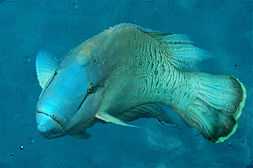Humphead wrasse
| Humphead wrasse | |
|---|---|
 | |
| Breeding male humphead wrasse in the Melbourne Aquarium | |
| Conservation status | |
| Scientific classification | |
| Kingdom: | Animalia |
| Phylum: | Chordata |
| Class: | Actinopterygii |
| Order: | Perciformes |
| Family: | Labridae |
| Genus: | Cheilinus |
| Species: | C. undulatus |
| Binomial name | |
| Cheilinus undulatus Rüppell, 1835 | |
| Synonyms | |
| |



The humphead wrasse, Cheilinus undulatus, is a species of wrasse mainly found on coral reefs in the Indo-Pacific region. It is also known as the Māori wrasse, Napoleon wrasse, Napoleon fish, Napoleonfish; and so mei 蘇眉 (Cantonese), mameng (Filipino), and merer in the Pohnpeian language of the Caroline Islands.[2]
Description
The humphead wrasse is the largest living member of the family Labridae, with males reaching 6 ft (2 m) in length, while females rarely exceed about 3 ft (1 m). It has thick, fleshy lips, and a hump forms on its head above the eyes, becoming more prominent as the fish ages, hence it name. Males range from a bright electric blue to pale green, a purplish blue, or a relatively dull blue/green. Juveniles and females are red-orange above, and red-orange to white below. Some males grow very large, with one unconfirmed report of a humphead wrasse that was 7.75 ft (2.29 m) long and weighed 420 lbs (190.5 kg). An even larger specimen is described in Captain Jacques Y. Cousteau's "The Living Sea" as being "...twelve to fifteen feet long and seven to eight feet high." as was quoted by Dumas and Falco. (p. 74)
Ecology
Adults are commonly found on steep coral reef slopes, channel slopes, and lagoon reefs in water 3 to 330 ft (1–100 m) deep. They are very opportunistic predators, preying primarily on crustaceans, mollusks (particularly gastropods), fish, and echinoderms. They are one of the few predators of toxic animals such as the sea hare Aplysia and boxfish Ostraciidae and have even been reported preying on crown-of-thorns starfish.[3] This species actively selects branching hard and soft corals and seagrasses at settlement. Juveniles tend to prefer a more cryptic existence in areas of dense branching corals, bushy macroalgae, or seagrasses, while larger individuals and adults prefer to occupy limited home ranges in more open habitat on the edges of reefs, channels, and reef passes. The species is most often observed in solitary male-female pairs, or groups of two to seven individuals.
Reproduction
Individuals become sexually mature at four to six years, and females are known to live for around 50 years, whereas males live a slightly shorter 45 years. Humphead wrasses are protogynous hermaphrodites, with some members of the population becoming male at about 9 years old[4] The factors that control the timing of sex change are not yet known. Adults move to the down-current end of the reef and form local spawning aggregations (they concentrate to spawn) at certain times of the year.
Conservation
The humphead wrasse is long-lived, but has a very slow breeding rate. Its numbers have declined due to a number of threats, including:
- Intensive and species-specific removal in the live reef food fish trade
- Spearfishing at night with SCUBA gear
- Destructive fishing techniques, including sodium cyanide and dynamite
- Habitat loss and degradation
- Juveniles being taken from the wild and raised or “cultured” in floating net cages until saleable size
- A developing export market for juvenile humphead wrasse for the marine aquarium trade
- Lack of coordinated, consistent national and regional management
- Illegal, unregulated, or unreported fisheries
In December 2003, Australia prohibited all take and possession of humphead wrasses, other than for limited educational purposes and public display. In Guangdong Province, southern mainland China, permits are required for the sale of this species; Indonesia allows fishing only for research, mariculture, and licensed artisanal fishing; the Maldives instituted an export ban in 1995; Papua New Guinea prohibits export of fish over 2 ft (65 cm) total length; and Niue has banned all fishing for this species.
The humphead wrasse is a U.S. National Marine Fisheries Service Species of Concern. Species of Concern are those species about which the NMFS, has some concerns regarding status and threats, but for which insufficient information is available to indicate a need to list the species under the Endangered Species Act.
See also
- Bumphead parrotfish (Bolbometopon muricatum)
References
- ↑ Russell, B. (Grouper & Wrasse Specialist Group) 2004. Cheilinus undulatus. In: IUCN 2013. IUCN Red List of Threatened Species. Version 2013.1. <www.iucnredlist.org>. Downloaded on 02 November 2013.
- ↑ http://www.trussel2.com/pnp/pnp-m.htm
- ↑ Randall, J.E., et al. (1978). Food habits of the giant humphead wrasse, Cheilinus undulatus (Labridae). Env. Biol. Fish 3:235-238
- ↑ Choat, J. H., et al. (2006). Age structure and growth in a large teleost, Cheilinus undulatus, with a review of size distribution in labrid fishes. Mar Ecol Prog Ser 318:237-246.
- "Cheilinus undulatus". Integrated Taxonomic Information System. Retrieved 24 January 2006.
- Froese, Rainer and Pauly, Daniel, eds. (2006). "Cheilinus undulatus" in FishBase. January 2006 version.
- The Red Sea (1995) Eds. Bonechi ISBN 88-8029-301-X
External links
| Wikispecies has information related to: Cheilinus undulatus |
| Wikimedia Commons has media related to Cheilinus undulatus. |
- Humphead wrasse at the Encyclopedia of Life
- Biological information on the above fish
- WWF site
- The Humphead Wrasse is a Threatened Reef Fish




